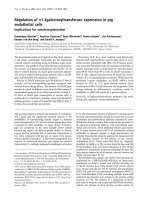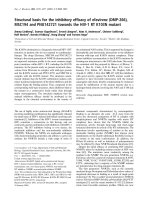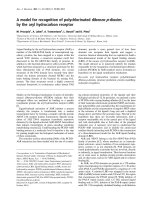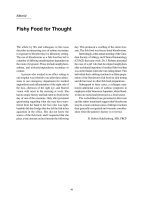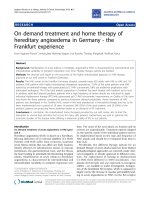Báo cáo y học: "Supplier-induced demand for psychiatric admissions in Northern New England" pdf
Bạn đang xem bản rút gọn của tài liệu. Xem và tải ngay bản đầy đủ của tài liệu tại đây (228.45 KB, 7 trang )
RESEARCH ARTICLE Open Access
Supplier-induced demand for psychiatric
admissions in Northern New England
Bradley V Watts
1
, Brian Shiner
1*
, Gunnar Klauss
2
and William B Weeks
3
Abstract
Background: The development of hospital service areas (HSAs) using small area analysis has been useful in
examining variation in medical and surgical care; however, the techniques of small area analysis are
underdeveloped in understanding psychiatric admission rates. We sought to develop these techniques in order to
understand the relationship between psychiatric bed supply and admission rates in Northern New England. Our
primary hypotheses were that there woul d be substantial variation in psychiatric admission across geographic
settings and that bed availability would be positively correlated with admission rates, reflecting a supplier-induced
demand phenomenon. Our secondary hypothesis was that the construction of psychiatric HSAs (PHSAs) would
yield more meaningful results than the use of existing gene ral medical hospital service areas.
Methods: To address our hypotheses, we followed a four-step analytic process: 1) we used small area analytic
techniques to define our PHSAs, 2) we calculated the localization index for PHSAs and compared that to the
localization index for general medical HSAs, 3) we used the number of psychiatric hospital beds, the number of
psychiatric admissions, and census data to calculate population-based bed-supply and psychiatric admission rates
for each PHSA, and 4) we correlated population-based admission rates to population-based psychiatric bed supply.
Results: The admission rate for psychiatric diagnosis varied considerably among the PHSAs, with rates varying from
2.4 per 100,000 in Portsmouth, NH to 13.4 per 100,000 in Augusta, ME. There was a positive correlation of 0.71
between a PHSA’s supply of beds and admission rate. Using our PSHAs produced a substantially higher localization
index than using general medical hospital services areas (0.69 vs. 0.23), meaning that our model correctly predicted
geographic utilization at three times the rate of the existing model.
Conclusions: The positive correlation between admission and bed supply suggests that psychiatric bed availability
may partially explain the variation in admission rates. Development of PHSAs, rather than relying on the use of
established general medical HSAs, improves the relevance and accuracy of small area analysis in understanding
mental health servi ces utilization.
Background
Small area analysis is a health services research technique
that facilitates geographic comparison of health services
utilization rates [1]. Using this technique, researchers have
consistently documented the existence of supplier-induced
demand [2] for health services [3-5]. Rates of procedures–
such as tonsillectomy, prostatectomy, and hysterectomy
[6]–and inpatient hospitalization rates for general medical
illnesses–such as back problems, gastroenteritis, and heart
failure [7]–have been shown to be related more strongly
to the supply of a service than to the need for that service
[8]. While small area analysis has not helped health sys-
tems determine the optimal supply of health services, it is
clear that small areas with the highest utilization rates
experience the worst health outcomes even in the face of
similar disease burdens [9,10]. This has spurred concerns
that an oversupply of health care may worsen health out-
comes for a population [10]. Chief among these concerns
is that once the true need for a health service has been
served, market forces dictate that excess supply must be
consumed by those who do not actually need the services
and are therefore exposed to the risk without the potential
for benefit [2]. While some conditions always merit treat-
ment, others–so-called high-variation conditions–tend to
* Correspondence:
1
Department of Psychiatry, Dartmouth Medical School, VA Medical Center,
215 North Main Street, White River Junction, VT 05009, USA
Full list of author information is available at the end of the article
Watts et al. BMC Psychiatry 2011, 11:146
/>© 2011 Watts et al; li censee BioMed Central Ltd. This is an Open Access ar ticle distributed under the terms of the Creative Commons
Attribution License ( licenses/by/2.0), which permits unrestricted use, distribution, and reproduction in
any medium, provided the original work is properly cited.
be treated more intensively in the presence of excess
resources [7]. The development of the Dartmouth Atlas of
Healthcare has facilitated the application of small area
analysis to national datasets and allowed the identification
of this phenomenon on a local level,[11] as in reports of
the over-provision of cardiac surgery in Re ading, Califor-
nia [12,13] and of unusually high rates of coronary stent
procedures in Elyria, Ohio [14,15]. Recent literature has
been more critical of the concept of supply inducted
demand in medicine. While there is general agreement
that utilization and supply are correlated, there is less
agreement regarding the meaning and drivers of this asso-
ciation [16].
While small area analysis has been extensively applied
to hospital- based medical and surgical services, there has
been little application to hospital-based psychiatric ser-
vices.A1995analysisofpsychiatric inpatient admission
patterns in Iowa found higher rates in small areas with
more primary care physicians, psychiatrists, and inpatient
psychiatric units [17]. The authors concluded both that
the differences were unlikely to be related to differences
in need and that demand for inpatient psychiatry services
was, in fact, sensitive to supply. However, there were sev-
eral limitations to this analysis. First, the authors used
standard hospital service areas (HSAs), which are based
upon where most Medicare recipients who live in contig-
uous zip codes obtain general inpatient hospital services.
As there are many more general hospitals than there are
psychiatric hospitals and general hospitals with psychia-
tric units, most of the HSAs did not contain a psychiatric
unit. This method did not allow researchers to account
for use of inpatient psychiatric services in neighboring
HSAs. An earlier analysis grouped these HSAs by county
into politically-defined community mental health center
(CMHC) catchment areas and found that access to
CMHC resou rces induced demand for inpatient psychia-
tric admissions [18]. However, the CMHC catchment
areas were not necessarily the same or even intended to
be the same as catchment areas for inpatient psychiatric
units. Perhaps the most comprehensive study o f geo-
graphic variation in inpatient mental health care exam-
ined county variation in New York [19]. This study found
that population variables such as poverty and population
density were highly correlated with mental health service
utilization. Furthermore, even when controlling for these
factors, proximity to inpatient care resulted in increased
utilization.
Often small area an alysis has examined specialty care
by aggregating HSAs into larger hospital referral regions
(HRRs). HRRs are based upon where most Medicare reci-
pients living in contiguous zip codes obtain heart surgery
and neurosurgery [11]. While useful for understanding
geographic health service use patterns in expensive,
highly technical procedures, these HRRs may not be as
useful for understanding utilization of psychiatric inpati-
ent services. As large inpatient psychiatric facilities are
sometimes located in areas that do not have a medical
referral hospital and as there is no analogous hierarchy of
complexity in psychiatric units (for example, university-
based psychiatric units do not necessarily offer more
complex or technical procedures than community-based
psychiatric units as is the case in medical hospitals), it is
unlikely that geographic patterns of referral would be the
same. A final concern with using standard HSAs is that
patients admitted to inpatient psychiatric units tend to be
younger than patients admitted to inpatient general med-
ical units. As a result, fewer patients are eligible for Medi-
care; Medicare billing data may not be the most
appropriate information to use to define HSAs in this
population. Another major limitation of the Iowa and
New York State studies is that they looked at only one
state. As HSAs often cross state lines, it may be more
meaningful to look at a region rather than a single state.
Another study examined geographic variation in inpati-
ent psychiatric admission in New York City [20]. The
authors relied on zip codes as their unit of analysis and
did not construct hospital service areas. They found that
patients residing in a zip code where an inpatient psychia-
tric unit was located were more likely to be admitted.
However, this analysis is subject to the same fallacy as the
Iowa and New York State data, given that many zip codes
did not have an inpatient psychiatric unit and that there is
no reason to believe patients obtain their medical care
within their zip code.
Therefore, if the intent is to study geographic variation
in inpatient psychiatric admissions, it would be most help-
ful if: 1) each HSA–in this case Psychiatric HSAs or
PHSAs–had at least one inpatient psychiatric hospital
located within its boundari es, 2) we knew the capacity
(number of psychiatric beds) of these inpatient psychiatric
units rather than simply whether they existed or not, 3)
we used the most population-relevant data (including
using all adult age groups) to define our PHSAs, 4) we
recognized that in some areas, espe cially along interstate
borders, people a re likely to live in one state and obtain
healthcare in another, and 5) we parted from the assump-
tion that these PHSAs will have some hierarchical regional
organization as seen in general medical HSAs.
One of our goals in this study was to define the adapta-
tions that would make small area analysis more relevant
to the study of psychiatric care. We chose inpatient psy-
chiatric treatment as a start ing point both because of the
large cost strain it places on the mental health treatment
system and becaus e of the previously-docum ented possi-
bility of supplier-induced demand in this sector. Inpatient
psychiatric treatment is an integral part of mental health
treatment in the United States. In 2000, an estimated
215,221 inpatient psychiatric beds in 3,202 hospitals
Watts et al. BMC Psychiatry 2011, 11:146
/>Page 2 of 7
accommodated 2,153,874 psychiatric hospitalizations at a
cost of almost 33 billion dollars [21]. The large capacity
of and costs associated with inpatient psychiatric care in
the US reflects its central role in the provision of care for
mental health patients. Overall, 74% of all mental health
care dollars are spent on inpatient care: Medicare spends
83% of its mental health care budget on inpatient treat-
ment,[22] 65% of State mental health spending is for
inpatient care, and Blue Cross/Blue Shield recently
reported that 66% of their m ental health care spending
was for inpatient care [23]. Despite the volume and cost
of inpatient psychiatric care, there is very little research
regarding its effectiveness. Indeed, no randomized clinical
trials have demonstrated effectiveness for inpatient care
in a general psychiatric population [24].
We had three hypotheses in conducting this study,
related to the actual subject at hand (inpatient psychiatric
admissions) and the method to be used (applying small
area analysis to mental health services). Our primary
hypotheses were that there would be substantial variation
in psychiatric admission across geographic settings and
that bed availability would be positively correlated with
admission rates, reflecting a supplier-induced demand
phenomenon. Our secondary hypothesis was that the con-
struction of psychiatric HSAs would yield more meaning-
ful results than the use of existing general medical HSAs.
This article reports the first small area analytic study of
mental health services utilization using discipline-specific
techniques. Our approach does not discount the consider-
able previous literature which has demonstrated other
important drivers of inpatient mental health care including
population factors (poverty and prevalence of mental ill-
ness), ambulatory treatment resources (availability and
quality), and geographic proximity of inpatient service.
Our focus on the quantity of inpatient mental health beds
reflects the relative paucity of research regarding this vari-
able compared to the important variables above.
Methods
To address our hypotheses, we followed a four-step ana-
lytic process: 1) we u sed small are a analytic techniques
to define our PHSAs, 2) we calculated the localizatio n
index for psychiatric hospital service areas and com-
pared that to the localization index for general medical
HSAs, 3) we used the number of psychiatric hospital
beds, the number of psychiatric admissions, and census
data to calculate population-based bed-supply and psy-
chiatric admission rates for each psychiatric service area,
and4)wecorrelatedpopulation-basedadmissionrates
to population-based psychiatric bed supply. This study
was approved by Dartmouth Medical School’s Commit-
tee for the Protec tion of Human Subjects, Hanover, NH
(CPHS # 20009).
Determination of psychiatric hospital service areas
We obtaine d 1997 hospitalization datasets for the states
of Maine, New Hampshire, and Vermont from the
Maine Health Care Finance Commission (Augusta), the
New Hampshire Department of Health and Human
Services (Concord), and the Vermont Department of
Health (Burlington), respectively. We chose 1997 both
because it allowed us to use 2000 census data and
because it allowed comparison with the Dartmouth
Atlas of Hea lth Care ge neral medical HSAs, whic h had
last been calculated for the 1996 edition [13]. Each data-
set included the patients’ age, gender, home ZIP Code,
discharg e diagnosis , length of stay, and the ZIP Code of
the treating hospital. Only hospitalizations related to
those D iagnostic Related Groups (DRG) specific to
psychiatry were used for this project. These included
DRG 424-437 corresponding to diagnosis of Depression,
Psychosis, Anxiety, Alcohol Dependence, Drug Depen-
dence, and Organic Mental Condition. We excluded all
hospitalizations of patients under age 18.
We defined PHSAs for these three states using the
standard methods of small area analysis [6]. First, we
used the home ZIP codes of p atients admitted with psy-
chiatric disorders to create a patient origin matrix for all
adult psychiatric admissions. We excluded patients
whosehomeZIPCodewasnotlocatedinMaine,
Vermont, or New Hampshire. Next, we determined
which hospitals provided care to patients in each ZIP
Code. For each patient ZIP code we identified the hospi-
tal which had a plurality of all psychiatric admissions.
Fina lly, neighbo ring ZIP Codes were assigned to PHSAs
to form contiguous ZIP Code defined areas. PHSAs
were allowed to have as many or as few component ZIP
Codes as dictated by the data so long as they remained
contiguous. A PHSA could contain more than one
hospital under two circumstances: when two or more
hospitals were located within the same zip code or
when combining hospitals allowed for a more contigu-
ous geographic area.
Determination of the Localization Index and comparison
with the Dartmouth Atlas of Health Care
We used standard techniques to determine the extent
which patients received care within the PHSA, known as
the “localization index.”[13] The localization index is the
percentage of psychiatric admissions in a given PHSA
that are admitted to a hospital within the s ame PHSA.
We determined the localization index for each PHSA. In
addition, mean total localization index for the PHSA
model was determined by combining the results of loca-
lization indexes for each PHSA. We then compared the
PHSA with the general medical HSAs developed using
all Medicare discharges for the Dartmouth Atlas of
Watts et al. BMC Psychiatry 2011, 11:146
/>Page 3 of 7
Health Care. Using the previously defined general medi-
cal HSAs, we determined a localization index using the
total psychiatric admission data obtained from the
states. We also determine d an overall localization index
for the general medical HSAs.
Calculation of the population-based psychiatric hospital
bed supply and psychiatric admission rate
PHSAs were defined by both the number of hospitals that
provided psychiatric admissions (range 1-4 hospitals per
PHSA) and by a geographically-defined group of ZIP
Codes. To determine the supply of psychiatric beds avail-
able, we simply added the number of psychiatric beds
associated with all of the hospitals in each PHSA. The psy-
chiatric bed numbers were determined by obtaining the
number of licensed psychiatric beds in 1997 from each
state department of health. We confirmed this bed num-
ber by discussion with staff at each hospital. Similarly, we
determined the total number of admissions associated
with each PHSA using the admission dataset. Because
total population of each PHSA varied, we obtained popu-
lation counts from the 2000 census. As we were only
interested in adult psychiatric care we only used census
populations 18 years and older. We used these data to cal-
culate the number of beds and admissions per 10,000 per-
sons in the associated geographic area.
Analysis
To give readers a sense of the inherent differences in psy-
chiatric admissions at the State level, we provide an analysis
of the demographics and primary diagnosis of psychiatric
admissions in 1997. W e used ANOVA to compare continu-
ous variables and the chi-square test to compare categorica l
variables. We used the Spearman’s correlation statistic to
compare the population based numbers of psychiatric beds
and admission rates because the bed supply was not nor-
mally distributed [25]. All statistical analyses were con-
ducted using STATA 8.0 (College Station, TX).
Results
In 1997, there were 22,503 total admissions for adults with
primary psychiatric illnesses in the three States examined
(Table 1). Female patients accounted for 53% of admis-
sions. The average length of stay was nine days with a
median length of stay of six days. The most common diag-
nostic groups admitted were psych osis-including major
depression, schizophrenia, and bipolar disorder (47%),
substance use disorder (23%), and neurosis-including axis
II disorders (12%). Patient age groups were 18-24 years
(14%), 25-44 years (48%), 45-64 years (22%), 65-74 years
(7%), and > 75 years (11%). At the State level, there was no
significant variation in the average length of stay, gender,
or ages of admission. With the exception of different rates
of admission for substance disorders, diagnoses were simi-
larly distributed across states.
Table 2 shows the admission rate in each PHSA. Of
the twenty-five PHSA, fifteen included only one hospital
with psychiatric beds, six had two hospitals with psy-
chiatric beds, three had three hospitals with psychiatric
beds, and one had four hospitals with psychiatric beds.
The lowest rate was 2.4 admissions per 10,000 popula-
tions in Portsmouth, New Hampshire and the highest
was 13.4 in Augusta, Maine. The calculated localization
index was 0.69, meaning that 69% of the pa tients
admitted from a PHSA went to a hospital within that
PHSA. The localization index for psychiat ric admissions
using the general medical HSAs developed for the Dart-
mouth Atlas of Health Care was 0.23, meaning that
general medical HSAs correctly predicted the location of
psychiatric care only 23% of the time.
Figur e 1 shows the various psychiatric hospital service
areas for Nor thern New England; PHSAs borders fre-
quently crossed State borders. The map shows the varia-
tion in admission rates. In some cases, PHSAs with the
very highest psychiatric admission rates are geographi-
cally juxtaposed with PHSAs with the very lowest psy-
chiatric admission rates. We found a positive correlation
Table 1 Characteristics of psychiatric admissions by state
All States NH ME VT
Total Population 3,119,527 1,235,791 1,274,915 608,821
Psychiatric Admissions 22,503 6,842 12,319 3,342
Percent Female 53% 56% 51% 57%
Length of Stay (days)
Mean (SD) 8.97
(11.83)
8.22
(10.12)
9.6
(13.81)
8.17
(9.42)
Median 6 6 7 6
Range 1-297 1-297 1-252 1-128
Diagnosis
Psychosis 47% 47% 45% 55%
Substance Use
Disorder
23% 22% 28% 11%
Neurosis 12% 11% 10% 16%
Detoxification 5% 4% 5% 2%
Organic Disorder 5% 7% 4% 5%
Adjustment Disorder 4% 3% 3% 6%
Personality Disorder 2% 3% 1% 4%
Other 3% 1% 4% 1%
Age
18-24 14% 12% 15% 13%
25-44 48% 47% 48% 49%
45-64 22% 22% 20% 22%
65-74 7% 7% 7% 6%
> 75 11% 12% 10% 10%
*Totals may be > 100% due to rounding
**p < 0.05
Watts et al. BMC Psychiatry 2011, 11:146
/>Page 4 of 7
of 0.71 between the supply of beds and the admission
rate in a PHSA (p < .001) (Figure 2).
Discussion
We found that the principles of small area analysis can be
applied to inpatient psychiatric care, that use of psychia-
tric-specific hospitalization to define inpatient psychiatric
service areas results in better localization indices than
does use of medical and surgical defined hospital service
areas, and that the substantial variation in admission
rates–which is not fully captured at the individual State
level–is associated with increased psychiatric bed supply.
The high degree of variabilit y and the association
between psychiatric bed supply and psychiatric admission
rates suggests a supplier induced demand phenomenon.
Our study represents an initial step in better under-
standing quality, consistency, and effectiveness of inpati-
ent psychiatric admission across larger geographic
settings. Further, our study justifies use of methods spe-
cific to psychiatry to analyze mental health admission s.
Similar modifications have been used for other services,
such as outpatient primary care [26] and outpatient psy-
chiatric services,[27] where established utilization pat-
terns for general inpatient medical care may simply not
be relevant. Our findings suggest that, for the purpose
of examining psychiatric admissions, th e development of
psychiatric specific hospital service areas is warranted.
Given the large improvement in localization index when
comparing our PHSAs to general medical HSAs, we
conclude that our findings are more accurate than those
found elsewhere.
Our study has several limitations. First, we did not
incorporate measures of quality or outcomes into the
analysis: such work was beyond the scope of this
exploratory study. While the addition of quality and out-
comes metrics would not change the v ariation seen in
admission rates, they could substantially c hange the
interpretation of those data. Incorporation of such data
woul d be important in trying to determine an appropri-
ate psychiatric admission rate. Second, we were not able
to incorporate different measures of population-based
need into the analysis. Should the populat ion of
Augusta, ME have substantially higher inpatient psychia-
tric service needs than the population of Portsmouth,
NH, the differenc es in population based admissio n rates
that we found might be justified. Regardless, the rela-
tionship between bed supply and admission rates war-
rants further investigation. Third, we were not able to
correct for alternative methods of treatment provision.
It may be that greater levels of intensive outpatient ser-
vices might have been provided as local substitutes for
bed supply, and that such service s resulted in lower
admission rates. If this is the case, and intensive outpati-
ent services are less costly than inpatient services, highly
bedded psychiatric hospital service areas might achieve
efficiencies by substituting intensive outpatient treat-
ment for inpatient services. We think that this is unli-
kely given He ndryx et al.’s finding that access to these
services may actually induced added demand for inpati-
ent psychiatric admission [18]. Finally, our analysis was
limited to the admission data from the hospitals that
provide admission data to the three states examined.
State psychiatric hospitals, veterans’ hospitals, and hos-
pitals outside the three states that might serve some of
each state’s population do not provide data to these
three states. It is possible that differing patterns of utili-
zation of those i npatients beds was present in different
PHSA. These important methodologic limitations simi-
larly limit our primary assertion, that supply inducted
demand existed in mental health care in Northern New
England. Supplier inducted demand reflects treatment in
excess of the treatment provided to improve outcomes
and meet patient preferences. As i ndicated above we
have no information regarding patients’ outcomes or
preferences, thus our main finding must be considered
quite preliminary.
Table 2 Psychiatric Admission Rates in Northern New
England
PHSA* Admission Rate/10,000
Portsmouth, NH 2.4
Rochester, NH 3.2
Burlington, VT 3.2
Rutland, VT 4.6
Nashua, NH 5.0
Laconia, NH 5.2
Fort Kent, ME 5.4
Manchester, NH 5.7
Lebanon, NH 5.9
Barre, VT 6.1
Berlin, NH 6.3
Presque Isle, ME 6.3
Bennington, VT 6.5
Concord, NH 6.6
Brattleboro, VT 7.0
Bath, ME 7.1
Rockport, ME 7.3
Bangor, ME 7.4
Keane, NH 8.1
Portland, ME 8.2
Waterville, ME 8.9
Lewiston, ME 9.3
Claremont, NH 9.5
South Portland, ME 10.7
Augusta, ME 13.4
*PHSA: Psychiatric Hospital Service Area.
Watts et al. BMC Psychiatry 2011, 11:146
/>Page 5 of 7
Conclusions
Inpatient psychiatric care remains a central feature of vir-
tually all mental health systems and represents a substan-
tial proportion of overall mental health care costs. The
demonstration of large amounts of variability in the rates
of inpatient admission begs the question, “What is the
appropriate rate?” While we did show an association
between inpatient mental health utilization and bed sup-
ply, it remains unclear if this relationship reflects too
many or too few beds. Furthermore, examination of a
singular association such as the one we found in isolation
should be done with caution, as previous studies have
shown that impor tant population and outpatient mental
health characteristics also exert influence on inpatient
utilization. Our findings suggest that further research
examining geographic variation in the provision of psy-
chiatric services and the re lationship of that variation t o
the supply of services is warranted. We believe that the
examination o f regions empirically derived from mental
health data offers clear advantages over examination of
artificially derived boundaries such as states or counties.
Our work also suggests that attempts to quantify mental
health servi ces (such as examining the number of mental
health beds in a region) can add to our understanding.
Considerable future work is warranted in this important
topic. Expanding the boundaries of study through exami-
nation of longitudinal trends would be a significant
advancement. In addition, examination of larger geo-
graphic regions would aid with fuller understanding of
Figure 1 Psychiatric Hospital Service Areas in Northern New England.
Figure 2 Populat ion-Based Psychiatric Bed Supply and
Admission Rates. Each dot represents a PHSA; r = 0.71, p = 0.0085.
Watts et al. BMC Psychiatry 2011, 11:146
/>Page 6 of 7
utilization. Considerable prior work has examined popu-
lation factors that may influence treatment need and
treatment utilization. Less work has been accomplished
in understanding treatment and provider characteristics
that may influence utilization. For example, poorly
designed and organized outpatient services could
decrease utilization and increase inpatient need, while
highly quality outpatient c are could decrease inpatient
use. Sufficient data granularity is nee ded in this area.
Similarly, we know little about the possible mechanisms
through which “supply-inducted demand ” occ urs (if it
even exists). Greater understand ing of those mechanism s
could add validity regarding the existence of the supplier-
induced demand phenomenon. Ultimate ly, care that
results in improved outcomes for patients is valuable,
thus understanding the un derly ing relationship between
a treatment type and outcomes is of considerable inter-
est. Establishing relationships between good behavioral
health in a population and particular rates of admission
would have important implications for determining psy-
chiatric bed availability in a population.
List of abbreviations
HSA: hospital service area; CMHC: community mental health center; HRR:
hospital referral region; PHSA: psychiatric hospital service area; CPHS:
committee for the protection of human subjects; ZIP: zoning improvement
plan; CPT: current procedural technology; ANOVA: analysis of variance.
Acknowledgements and funding
This work was supported by Veterans Health Administration, Health Services
Research and Development Research Enhancement Award Program (REAP)
grant # REA 03-098. Dr. Shiner’s time is supported by the VA-New England
Early Career Development Award Program.
Author details
1
Department of Psychiatry, Dartmouth Medical School, VA Medical Center,
215 North Main Street, White River Junction, VT 05009, USA.
2
Department of
Anesthesiology, Wake Forest University School of Medicine, 100 Medical
Center Boulevard, Winston-Salem, NC 27157, USA.
3
The Dartmouth Institute
for Health Policy and Clinical Practice, 46 Centerra Parkway, Box 203,
Lebanon NH 03766, USA.
Authors’ contributions
BVW designed the study, obtained the data, and drafted the initial
manuscript. BS assisted in data collection and interpretation of the results,
and revised the manuscript. GK performed statistical analysis. WBW
conceived the study and provided intellectual supervision. All authors read
and approved the final manuscript.
Competing interests
The authors declare that they have no competing interests.
Received: 22 December 2010 Accepted: 9 September 2011
Published: 9 September 2011
References
1. Goodman DC, Green GR: Assessment tools: small area analysis. Am J Med
Qual 1996, 11(1):S12-14.
2. Folland S, Goodman AC, Miron S: The Economics of Health and Healthcare. 6
edition. Boston: Prentice Hall; 2009.
3. Wennberg JE, Barnes BA, Zubkoff M: Professional uncertainty and the
problem of supplier-induced demand. Soc Sci Med 1982, 16(7):811-824.
4. Wennberg JE: On patient need, equity, supplier-induced demand, and
the need to assess the outcome of common medical practices. Med Care
1985, 23(5):512-520.
5. Wennberg JE: Future directions for small area variations. Med Care 1993,
31(5 Suppl):YS75-80.
6. Wennberg J, Gittelsohn : Small area variations in health care delivery.
Science 1973, 182(117):1102-1108.
7. Wennberg JE, Freeman JL, Culp WJ: Are hospital services rationed in New
Haven or over-utilised in Boston? Lancet 1987, 1(8543):1185-1189.
8. Ashton CM, Petersen NJ, Souchek J, Menke TJ, Yu HJ, Pietz K,
Eigenbrodt ML, Barbour G, Kizer KW, Wray NP: Geographic variations in
utilization rates in Veterans Affairs hospitals and clinics. N Engl J Med
1999, 340(1):32-39.
9. Fisher ES, Wennberg DE, Stukel TA, Gottlieb DJ, Lucas FL, Pinder EL: The
implications of regional variations in Medicare spending. Part 1: the content,
quality, and accessibility of care. Ann Intern Med 2003, 138(4):273-287.
10. Fisher ES, Wennberg DE, Stukel TA, Gottlieb DJ, Lucas FL, Pinder EL: The
implications of regional variations in Medicare spending. Part 2: health
outcomes and satisfaction with care. Ann Intern Med 2003, 138(4):288-298.
11. The Dartmouth Atlas of Healthcare. [ />12. Pollack A: California patients talk of needless heart surgery. The New York
Times 2002.
13. Wenneberg JE, Cooper MM: The Dartmouth Atlas of Health Care in the
United States Chicago: American Hospital Publishing; 1996.
14. Abelson R: Heart procedure is off the charts in an Ohio city. The New
York Times 2006.
15. Coronary Revascularization: Coronary Artery Bypass Grafting and
Percutaneous Coronary Interventions. [ />downloads/reports/Cardiac_report_2005.pdf].
16. Leonard C, Stordeur S, Roberfroid D: Association between physician
density and health care consumption: A systematic review of the
evidence. Health Policy 2009, 91 :121-134.
17. Hendryx MS, Urdaneta ME, Borders T: The relationship between supply
and hospitalization rates for mental illness and substance use disorders.
J Ment Health Adm 1995,
22(2):167-176.
18. Hendryx MS, Rohland BM: A small area analysis of psychiatric
hospitalizations to general hospitals. Effects of community mental
health centers. Gen Hosp Psychiatry 1994, 16(5):313-318.
19. Curtis S, Congdon P, Almog M, Ellermann R: County variation in use of
inpatient and ambulatory psychiatric care in New York State 1999-2001:
Need and supply influences in a structural model. Health & Place 2009,
15:568-577.
20. Almog M, Curtis S, Copeland A, Congdon P: Geographical variation in
acute psychiatric admissions within New York City 1990-2000: growing
inequalities in service use? Soc Sci Med 2004, 59(2):361-376.
21. Manderscheid RW, Herderson MJ: Mental health, United States, 2002
Executive Summary. Administration and Policy in Mental Health 2004,
32(1):49-55.
22. Ettner SL, Hermann RC: Inpatient psychiatric treatment of elderly
Medicare beneficiaries. Psychiatric Services 1998, 49(9):1173-1179.
23. Vallon KR, Foti ME, Langman-Dorwart N, Gatti E: Comprehensive case
management in the private sector for patients with severe mental
illness. Psychiatric Services 1997, 48(7):910-914.
24. Salokangas RK, Honkonen T, Stengard E, Koivisto AM: Mortality in chronic
schizophrenia during decreasing number of psychiatric beds in Finland.
Schizophrenia Research 2002, 54(3):265-275.
25. Howell DC: Statistical Methods for Psychology. Seventh edition. Belmont, CA:
Cengage Wadsworth; 2010.
26. Goodman DC, Mick SS, Bott D, Stukel T, Chang CH, Marth N, Poage J,
Carretta HJ: Primary care service areas: A new tool for the evaulation of
primary care services. Health Services Research 2003, 38(1):287-309.
27. Eveland AP, Dever GE, Schafer E, Sprinkel C, Davis S, Rumpf M: Analysis of
health service areas: another piece of the psychiatric workforce puzzle.
Psychiatr Serv 1998, 49(7):956-960.
Pre-publication history
The pre-publication history for this paper can be accessed here:
/>doi:10.1186/1471-244X-11-146
Cite this article as: Watts et al.: Supplier-induced demand for psychiatric
admissions in Northern New England. BMC Psychiatry 2011 11:146.
Watts et al. BMC Psychiatry 2011, 11:146
/>Page 7 of 7


